![]()
![]()
![]()
Use LEFT and RIGHT arrow keys to navigate between flashcards;
Use UP and DOWN arrow keys to flip the card;
H to show hint;
A reads text to speech;
82 Cards in this Set
- Front
- Back
|
4 components of Major Macromolecules |
- Chemical nature of monomers - Synthesis of polymers - Properties of polymers - Functions |
|
|
Protein: Monofunctional |
When a protein has a specific function. |
|
|
Protein: Bifunctional |
When a protein has two distinctly different roles. |
|
|
Protein Type: Enzymes |
Fx: Selective Catalysis (i.e. Digestive Enzyme) |
|
|
Protein Type: Structural |
Fx: Support Cellular Structures (i.e. Collagen and Elastin) |
|
|
Protein Type: Motility |
Fx: Cell and parts movement (i.e. Actin and Myosin) |
|
|
Protein Type: Regulatory |
Fx: Cellular Function (i.e. Transcription factors DNABP) |
|
|
Protein Type: Transport |
Fx: Substance in and out (i.e. trans membrane for small molecules) |
|
|
Protein Type: Hormonal |
Fx: Hormones (i.e. Insulin, GH) |
|
|
Protein Type: Defensive |
Fx: Against Disease (i.e. Antibodies) |
|
|
Protein Type: Storage |
Fx: Storage and release of AA (i.e. in seed broken down for AA requirement) |
|
|
Monomer |
A monomer is another term used to classify an Amino Acid (AA). |
|
|
Are there proteins that share identical AA sequences with proteins. |
NO. No two proteins share identical AA sequences. |
|
|
30 most common small molecules in cells. |
20 - Amino Acids
5 - Aromatic Bases (purines and pyrimidines)
2 - Sugars (ribose and glucose)
3 - Lipids (choline, glycerol, palmitate) |
|
|
20 Amino Acids |
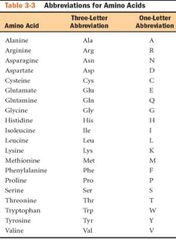
|
|
|
5 Aromatic Bases |
PURINES - Adenine - Guanine PYRIMIDINES - Cytosine - Thymine - Uracil Components on nucleic acids (DNA and RNA) |
|
|
2 Sugars (monosaccharides) |
Ribose - component of nucleic acids. Glucose - energy metabolism; component of starch and glycogen. |
|
|
3 Lipids |
Choline Glycerol Palmitate
- Components of phospholipids |
|
|
20 Amino Acids - 9 Non-Polar |
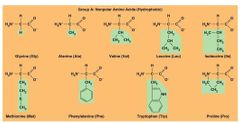
|
|
|
20 Amino Acids - 6 polar uncharged amino acids (hydrophillic) |

|
|
|
20 Amino Acids - 5 polar, charged amino acids |

|
|
|
Addition reactions between Amino Acids... |
Are known as Dehydration/Condensation reactions. Resulting in the formation of water and the formation of a Peptide/Amide bond. |
|
|
Steps of Amino Acid addition reactions... |
- Condensation/Dehydration reaction. - Formation of Peptide/Amide bond. - Directional continuation; either at N Terminus (Amino Group) and the C Terminus (Carboxyl Group) |
|
|
Requirements of Polypeptide Synthesis |
Information and Energy - Energy needed for incoming Amino Acid - Amino Acid linked to transfer RNA or tRNA - messenger or mRNA is used as template |
|
|
Two Amino Acid chain |
Dipeptide |
|
|
Three Amino Acid chain |
Tripeptide |
|
|
Several Amino Acid chain |
Polypeptide |
|
|
Monomeric Proteins |
Single peptide which achieve a shape from spontaneous folding and coiling. |
|
|
Multimeric Proteins |
Two or more polypeptides |
|
|
Multimeric - Homomeric |
Identical polypeptides |
|
|
Multimeric - Heteromeric |
Two or more different polypeptides. |
|
|
How many polypeptides in Hemoglobin? |
Hemoglobin contains four polypeptides. |
|
|
What are the four subunits of Hemoglobin? |
2 - alpha globulin subunits
2 - beta globulin subunits |
|
|
Why do proteins have conformations? |
Proteins fold into a proper shape or Conformation to accomplish their biological goals. |
|
|
Conformation depends on what kind of bonds? |
Covalent Disulfid bonds & Non-covalent bonds |
|
|
Conformation: Disulfide Covalent Bonds |
Intramolecular Disulfide Bonds - between Cysteine residues of the same protein stabilize the conformation of polypeptide. |
|
|
Confirmation: Non-covalent Bonds |
Hydrogen Bonds
Ionic Bonds
Van der Waals Interactions
Hydrophobic Interactions |
|
|
Non-covalent Bonds: Hydrogen Bonds |
Stabilizes helical and sheet structures.
R- Groups in amino acids can act as H donor or acceptors. This allows H bonds tho form at safe distances with AA.
Carbonyl and Sulfhydryl are good acceptors. And, OH groups are good donors.
Individual H bonds are weak but many together can stabilize biopolymers. |
|
|
9 Nons (20 AA) |
Gly - Ala - Val - Leu- Ile Met - Phe - Trp - Pro |
|
|
6 Neuts (20 AA) |
Ser - Thr - Cys - Tyr - Asn - Gln |
|
|
5 Poles (20 AA) |
Asp - Glu Lys - Arg - His |
|
|
Non-covalent Bonds: Ionic Bonds |
R-Grpups are (+) or (-) charged.
Ionic bons are nondirectional - meaning they are not limited to discrete angles.
Loss of ionic bonds account for the denaturation of protein which are subjected to unfavorable pH. |
|
|
Non-covalent Bonds: Vaan der Wals |
Molecules with non-polar covalent bonds that contain transient negative and positive charged regions.
Electrons are unevenly and asymmetriclly distributed.
Transient attraction between two nonpolar molecules. This requires close proximity.
Table for the binding of molecules with complementary surfaces. |
|
|
Non-covalent Bonds: Hydrophobic |
Not a bond or interaction. A term used to explain the tendency of a molecule or parts of a molecule to avoid reacting with water. |
|
|
Stability of protein structure/folding |
1. Covalent Disulfide bonds. 2. Hydrogen bonds between r- groups. 3. Iconic bonds - between charged amino acids. 4. Transient Vaan der Wals forces - nonpolar molecules. 5. Hydrophobic interactions with non-polar groups in the interior. |
|
|
4 Levels of Protein Structure |
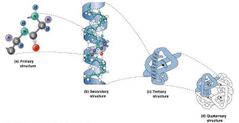
1. Primary 2. Secondary 3. Tertiary 4. Quaternary |
|
|
The 2 Protein Categories |
1. Fibrous Proteins (small number) 2. Globular Proteins |
|
|
Fibrous Proteins (small number) |
- Fibroin - Keratins - Collagen - Elastin |
|
|
Globular Proteins |
Most proteins in cellular structure and function. |
|
|
Path of Genetic Information |
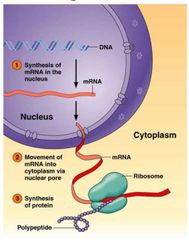
1 - mRNA forms inside nucleus. 2 - mRNA leaves nucleus via nuclear pores. 3 - mRNA sticks to ribosome, initiating protein formation. |
|
|
Nucleic Acid Synthesis |

Requires energy from nucleotides and information via the DNA template. Hydrogen bonds form between the carbonyl groups and nitrogen atoms of purines and pyrimidines bases. |
|
|
Polysaccharides (Part 1) |
Sugar and sugar derivative polymers. Repeating Unit - six carbon sugar glucose. Single or Two kinds of alternating patterns. Not an informational polymer. Structural and energy polymers. Storage - Starch and Glycogen. Shorter Polymers - Oligosaccharides - attached to proteins on cell surface. |
|
|
Polysaccharides (Part 2) |
Play roles - signaling by recognizing extras signaling molecules. Six carbon sugar glucose is single repeating unit. Differ in nature of the bond and branch chains. |
|
|
Polysaccharides (Part 3) |
Monomers - Monosaccharides - Sugar Aldehyde or Ketone - Aldosugar with Terminal carbonyl group. - Ketosugar with internal carbonyl. |
|
|
Structure of Monosaccharides (Monomers) |
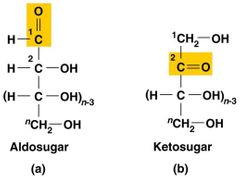
|
|
|
Disaccharides |
Two monomeric saccharides linked covalently. - Maltose (Two glucose units) - Lactose (Glucose linked to Galactose) - Sucrose (Glucose linked to Fructose)
Disaccharides formed by condensation and by Glycosidic bond.
|
|
|
How are sugars named? |
Sugars are named based on number of carbon atoms
Three Carbon - Triose Four Carbon - Tetrose Five Carbon - Pentose Six Carbon - Hexose |
|
|
The Two ring forms of D-Glucose |
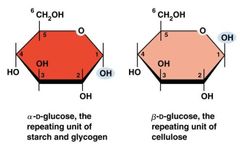
Alpha and Beta glucose.
Alpha can be broken down by humans.
Beta can only be broken down by bacteria. |
|
|
Common Disaccharides |
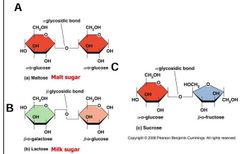
|
|
|
Polysaccharides (Part 4) |
Structural and Storage Starch - Storage in plant cells. Glycogen - storage in animal cells. These polymers consist of Glucose units lined together by Glycosidic bonds. |
|
|
Glycogen |
Storage polysaccharide in animal cells.
- Alpha linkage
- consists of Glucose units lined together by Glycosidic bonds.
- highly branched with linkages at every 8 to 10 glucose units to provide side chains roughly 8 to 12 glucose units long. |
|
|
Starch |
Alpha linkage Branched - Amylose (10-30%) Unbranched - Amylopectin (70-90%) Branches every 12 to 25 glucose units. With long side chains, 20 to 25 glucose units long. More than half the carbon in plants is Cellulose. |
|
|
Lipids |
• Heterogenous molecules - functionally and chemically diverse. • NOT formed by stepwise processes. • Resemblance by property of solubility. • HYDROPHOBIC • Soluble in nonpolar solvents - chloroform or ether. • Some are Amphipathic - containing polar and nonpolar regions. |
|
|
Lipid Functions |
Energy Storage. Membrane Structure. Special Function. |
|
|
Lipids - Six Main Classes |
1. Fatty Acids 2. Triacylglycerols 3. Phospholipids 4. Glycolipids 5. Steroids 6. Terpenes |
|
|
Fatty Acids |
• Building blocks: long unbranched hydrocarbon chains with carboxy group at the end. • Amphipathic - head polar and tall nonpolar. • Number of carbon atoms vary. • Yield energy upon oxidation. • Saturated (No double bonds) vs Unsaturated (Double bonds present) |
|
|
Triacylglycerols |

Commonly known as Triglycerides: storage Lipids that provide energy and insulation. Glycerol molecule with three fatty acids by ester bonds. |
|
|
Triacylglycerol - Sat. vs Unsat. |
Saturated fatty acids with triacylglycerols, semisolid at room temperature. Unsaturated fatty acids with triacylglycerol, mostly liquid at room temp. |
|
|
Phospholipids |

Fatty acids esterfied into glycerol molecules. Phosphatidic Acid - basic component Amphipathic Nature - highly polar heads and two nonpolar heads. Sphingolilids - amine alcohol sphingosine. Ceramides - polar region flanked by two long nonpolar tails. |
|
|
Ceramides |
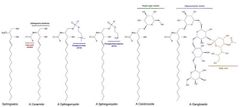
Polar region flanked by two long nonpolar heads |
|
|
Phospholipids - Self Organization |
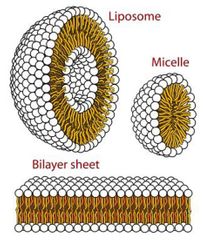
|
|
|
Structures of common Phosphoglycerides (Part 1) |
Phosphatidic Acid (+) R-Group |
|
|
Structures of Common Phosphoglycerides (Part 2) - Phospatidic Acid |
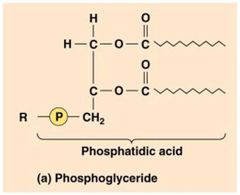
|
|
|
Structures of Common Phosphoglycerides (Part 3) - Common R-Groups |

Serine, Ethanolamine, Choline, Inositol. |
|
|
Glycolipids - General Structure |
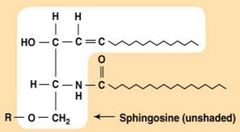
|
|
|
Glycolipids (Part 1) |
Derivatives of sphingolipids
Glycosphingolipids
Carbohydrate attached to a sugar unit.
Carbohydrate group - one to six sugar unit, D-Glucose, D-Galactose, N-acetyl-D-galactosamine. |
|
|
Glycolipids (Part 2) |
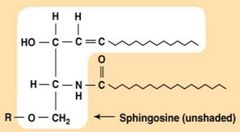
Found in some membranes - certain plant cells and nervous system. |
|
|
Steroids (Part 1) |
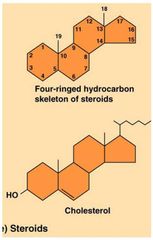
Four ringed hydrocarbon Cholesterol Amphipathic - OH group at the 3rd position - polar Four rings and hydrocarbon - nonpolar Found only in membranes. |
|
|
Steroids (Part 2) |

Steroid hormones – glucocorticoids and mineralocorticoids, Estrogens (estradiol), androgens (Testosterone).
Stigmasterol, sitosterols – Plants
Ergosterol – Fungus |
|
|
Common Steroid Hormones |
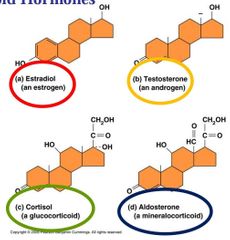
|
|
|
Terpenes |
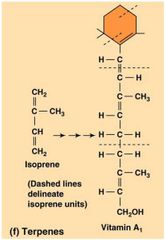
Formed from five carbon compound isoprene. - Isoprenoids Polyisoprenoids - found in Archea cell membrane. Involved in activating sugar derivative and electron carriers Coenzyme Q and Plastoquinone. Products are Vitamin A1, Cartinoids, and Dolichols, etc. |
|
|
Common Structural Motifs - β-α-β |
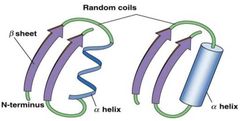
The α- helix is represented by blue a blue coil (left) or a blue cylinder (right). |

